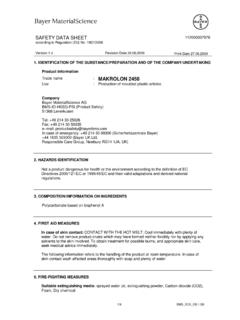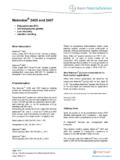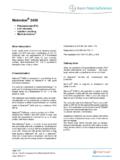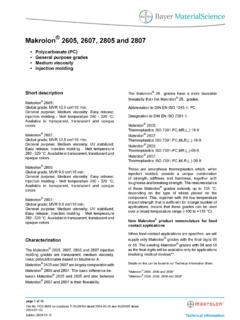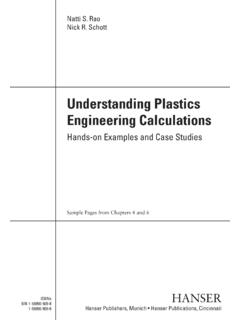Transcription of Makrolon 2205 and 2207 Makrolon - lidorr.com
1 Page 1 of 8 File No. PCS-8028 en (replaces TI PCS-8028 of 2008-03-19)Edition 2009-05-11 Technical InformationMakrolon 2205 and 2207 Polycarbonate (PC) General purpose grades Low viscosity Injection moldingShort descriptionMakrolon 2205:Global grade; MVR (300 kg) 35 cm /10 min;general purpose; low viscosity; easy release; injectionmolding - melt temperature 280 - 320 C; available intransparent, translucent and opaque colorsMakrolon 2207:Global grade; MVR (300 kg) 35 cm /10 min;general purpose; low viscosity; UV stabilized; easyrelease; injection molding - melt temperature 280- 320 C; available in transparent, translucent andopaque colorsCharacterizationThe Makrolon 2205 and 2207 injection moldinggrades are transparent, very easy flowing, linearpolycarbonates based on bisphenol A, with a lowmolecular Makrolon grades are noted for their verygood melt flow properties and are thus suitable forthe production of moldings with an unfavorable flowlength/wall thickness ratio, for the production oflarge moldings with thin with grades that have a high melt viscosity( Makrolon and ), Makrolon 2205 and 2207have a lower level of toughness, but this is stilladequate for a large number of to DIN EN ISO 1043-1: PCDesignation to DIN EN ISO 7391-1: Makrolon 2205:Thermoplastics ISO 7391-PC, MR,(,,)-24-9 Makrolon 2207.
2 Thermoplastics ISO 7391-PC, MLR,(,,)-24-9 Delivery formGranules, packed in 25-kg polyethylene sacks, bigbags, octatainer with a polyethylene inliner or in Makrolon batches are homogenized 2205 and 2207 are supplied in transparent,translucent and opaque colors with an outstandingcolor the properties of these products are influencedby opaque pigments, grades with opaque pigmentsare only available on production plants for Makrolon have been certifi-cated to DIN ISO by the appropriate quality organiza-tions. The certificates can be found in the INTERNETat (Customer Services / Certificates).Registered customers can access Safety Data Sheeton the Internet ( ). It can also besent on Safety Data Sheet includes data on labeling,transport and storage, as well as information on han-dling, product safety and toxicological and 2 of 8 File No. PCS-8028 en (replaces TI PCS-8028 of 2008-03-19)Edition 2009-05-11 Technical InformationApplicationsThe very good flowability of Makrolon 2205 and2207 makes these grades particularly suitable for theproduction of transparent, low-stress parts with thinwalls and long flow paths ( lamp diffusers).
3 Properties (see also table) Makrolon 2205 and 2207 display excellent flowabilityfor thermal and electrical properties are largelyidentical to those of the higher-molecular grades;however, the higher-molecular grades offer greatertoughness and resilience and better stress / drying1) Makrolon must be dried before processing. Forinjection molding no more than % residualmoisture may be present in the granules and, forextrusion, no more than %. Moisture in the meltleads to surface defects and a more marked reductionin molecular should be dried in suitable dryers at120 drying time for moist granules is largely a functionof the nature and type of the drying unit and can takebetween 2 and 12 hours depending on the dryingcapacity. Drying times of 2 to 4 hours are sufficient inmodern high-speed dryers. One means of dispensingwith pre-drying is for the moisture to be removedduring melting with the aid of a degassing unit, as isstandard practice in molding1) Makrolon can be processed on all modern injectionmolding machines.
4 Shut-off nozzles are suitable givensufficient, uniform heating. At high melt temperatures,melt can flow out of open nozzles. Molding shrinkageis more or less identical in all directions and amountsto between to %.The melt temperatures generally employed duringprocessing are between 280 and 320 damage has to be expected with excessivelyhigh processing temperatures or excessively longresidence times in the cylinder and hot runner. Thiscan lead to a reduction in toughness and/or to surfacedefects in the form of should be possible for the molds to be heated inten-sively and uniformly, and the mold temperature shouldbe at least 80 C to ensure parts with a low inherentstress and a good surface. No demolding difficultiesare encountered at up to 120 C. It will not generallybe necessary to employ mold release agents whenMakrolon grades with easy mold release are the recommended processing conditions smallquantities of decomposition product may be given offduring processing.
5 To preclude any risk to the healthand well-being of the machine operatives, tolerancelimits for the work environment must be ensured bythe provision of efficient exhaust ventilation and freshair at the workplace in accordance with the SafetyData order to prevent the partial decomposition of thepolymer and the release of volatile decompositionproducts, the prescribed processing temperaturesshould not be substantially )Details on this can be found in our Technical Information Sheet."Determining the dryness of Makrolon by the TVI test"""Processing data for the injection molder"""The Injection Molding of High-Quality Molded Parts"RecyclingRejects and production waste can be reground,observing the drying and processing advice for virginmaterial, and made into new moldings. It is essentialto check the property level and the color of moldingcompounds that contain regrind with respect tothe envisaged application. The permissible regrindcontent must be established on a case-by-case using regrind, it should be borne in mindthat the granule geometry, which differs from thatof extrusion granules, will influence the feed andplastication behavior.
6 For this same reason, physicalmixtures of regrind and granules tend to segregateon account of the movement they experience duringtransport, conveying and metering 3 of 8 File No. PCS-8028 en (replaces TI PCS-8028 of 2008-03-19)Edition 2009-05-11 Technical InformationWhen Makrolon is reprocessed, care should betaken to ensure that no foreign materials or dirtare incorporated. Waste that contains pollutantsand mixed waste can be chemically recycled orincinerated with energy Makrolon waste can be disposed ofin an environmentally compatible manner through thecorrect form of incineration and subsequent dumpingof the should be identified in accordance with DINEN ISO 11469; the marking to be applied to parts inMakrolon 2205 and 2207 is as follows:>PC<Details on this can be found in our Technical Information Sheet "Partidentification of thermoplastics for recycling".Shear Rate in 1/sViscosity in Pa s260 C280 C300 C320 C1E11E21E31E41E51E11E21E31E4 Fig.
7 1: Melt viscosity as a function of shear rate ( Makrolon 2205, 2207)page 4 of 8 File No. PCS-8028 en (replaces TI PCS-8028 of 2008-03-19)Edition 2009-05-11 Technical InformationStrain in %Stress in MPa-40 C-20 C0 C23 C40 C60 C90 C120 C0246810020406080100 Fig. 2: Isothermal stress-strain curves from the short-time tensile test to ISO 527-1, -2 ( Makrolon 2205, 2207)Temperature in CShear Modulus G'Shear Loss Modulus G''Shear Loss Factor Tan DeltaG'G''tan d-60-1040901401901E01E11E21E31E41E-31E-2 1E-11E01E1 Fig. 3: Shear modulus as a function of temperature to ISO 6721-1, -2 ( Makrolon 2205, 2207)page 5 of 8 File No. PCS-8028 en (replaces TI PCS-8028 of 2008-03-19)Edition 2009-05-11 Technical InformationTypical ValuesPropertyTest ConditionUnitStandardMakrolon 22052207 Rheological propertiesCMelt volume-flow rate300 C; kgcm /10 minISO 11333535 CMolding shrinkage, parallel60x60x2; 500 bar%ISO shrinkage, normal60x60x2; 500 bar%ISO shrinkage, parallel/normalValue range based on generalpractical experience% ISO - - mass-flow rate300 C; kgg/10 minISO 11333737 Mechanical properties (23 C/50 % r.)
8 H.)CTensile modulus1 mm/minMPaISO 527-1,-224002400 CYield stress50 mm/minMPaISO 527-1,-26566 CYield strain50 mm/min%ISO 527-1, strain at break50 mm/min%ISO 527-1,-2> 50> 50 Stress at break50 mm/minMPaISO 527-1,-26060 Strain at break50 mm/min% ISO 527-1,-2115115 CTensile creep modulus1 hMPaISO 899-121002100 CTensile creep modulus1000 hMPaISO 899-117001700 Flexural modulus2 mm/minMPaISO 17823502350 Flexural strength2 mm/minMPaISO 1789798 Flexural strain at flexural strength2 mm/min%ISO stress at % strain2 mm/minMPaISO 1787374 CCharpy impact strength23 CkJ/m ISO 179-1eUNNCC harpy impact strength-30 CkJ/m ISO 179-1eUNNC harpy impact strength-60 CkJ/m ISO 179-1eUNNC harpy notched impact strength23 C; 3 mmkJ/m ISO 7391 ISO179-1eA55P(C)55P(C)Charpy notched impact strength-30 C; 3 mmkJ/m ISO 7391 ISO179-1eA12C12 CIzod notched impact strength23 C; mmkJ/m ISO 180-A65P(C)65P(C)Izod notched impact strength-30 C; mmkJ/m ISO 180-A12C12 CCPuncture maximum force23 CNISO 6603-249004900 CPuncture maximum force-30 CNISO 6603-259005900 CPuncture energy23 CJISO 6603-25555 CPuncture energy-30 CJISO 6603-26060 Ball indentation hardnessN/mm ISO 2039-1115116page 6 of 8 File No.
9 PCS-8028 en (replaces TI PCS-8028 of 2008-03-19)Edition 2009-05-11 Technical InformationTypical ValuesPropertyTest ConditionUnitStandardMakrolon 22052207 Thermal propertiesCGlass transition temperature10 C/min CISO 11357-1,-2145144 CTemperature of deflection under MPa CISO 75-1,-2124123 CTemperature of deflection under MPa CISO 75-1,-2137136 CVicat softening temperature50 N; 50 C/h CISO 306145144 Vicat softening temperature50 N; 120 C/h CISO 306146145 CCoefficient of linear thermal expansion, parallel23 to 55 C10-4/KISO 11359-1, of linear thermal expansion, transverse23 to 55 C10-4/KISO 11359-1, behavior UL 94 ( mm) mmClassUL 94V-2 (CL)V-2 (CL)CBurning behavior UL mmClassUL 94V-2 (CL)V-2 (CL)Burning behavior UL mmClassUL 94V-2 (CL)V-2 (CL)Burning behavior UL mmClassUL 94HB (CL)HB (CL)COxygen indexMethod A%ISO 4589-22727 Thermal conductivity23 CW/(m K)ISO to heat (ball pressure test) CIEC 60695-10-2136135 Relative temperature index (Tensile strength) mm CUL 746B8080 Relative temperature index (Tensile impact strength) mm CUL 746B8080 Relative temperature index (Electric strength) mm CUL 746B8080 Glow wire test (GWFI) mm CIEC 60695-2-12850850 Glow wire test (GWFI) mm CIEC 60695-2-12850850 Glow wire test (GWFI) mm CIEC 60695-2-12850850 Glow wire test (GWFI) mm CIEC 60695-2-12930930 Glow wire test (GWFI) mm CIEC 60695-2-12960960 Glow wire test (GWIT)
10 Mm CIEC 60695-2-13875875 Glow wire test (GWIT) mm CIEC 60695-2-13875875 Glow wire test (GWIT) mm CIEC 60695-2-13875875 Glow wire test (GWIT) mm CIEC 60695-2-13875875 Glow wire test (GWIT) mm CIEC 60695-2-13875875 Application of flame from small burnerMethod K and F; mmClassDIN 53438-1,-3K1, F1K1, F1 Needle flame testMethod K; mmsIEC 60695-2-255 Needle flame testMethod K; mmsIEC 60695-2-255 Needle flame testMethod K; mmsIEC 60695-2-21010 Needle flame testMethod F; mmsIEC 60695-2-26060 Needle flame testMethod F; mmsIEC 60695-2-2120120 Needle flame testMethod F; mmsIEC 60695-2-2120120 Burning rate (US-FMVSS)>= mmmm/minISO 3795passedpassedFlash ignition temperature CASTM D1929480480 Self ignition temperature CASTM D1929550550 Electrical properties (23 C/50 % r. h.)CRelative permittivity100 Hz-IEC permittivity1 MHz-IEC factor100 Hz10-4 IEC 6025055 CDissipation factor1 MHz10-4 IEC 602509090 CVolume resistivityOhm mIEC 600931E141E14 CSurface resistivityOhmIEC 600931E161E16 CElectrical strength1 mmkV/mmIEC 60243-13434 CComparative tracking index CTIS olution ARatingIEC 60112250250 Comparative tracking index CTI MSolution BRatingIEC 60112125M125 MElectrolytic corrosionRatingIEC 60426A1A1page 7 of 8 File No.
